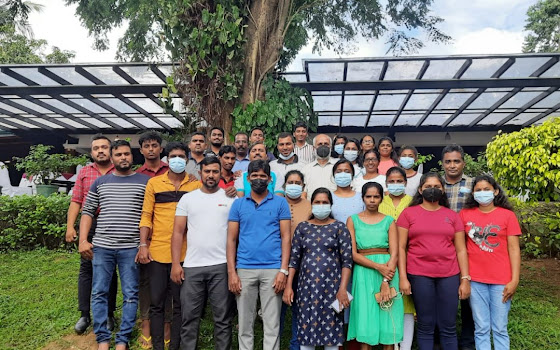The Blue Club is an Indian grassroots media organization that strives to ”pass the mic and amplify the voices of the suppressed who have been deliberately silenced and muffled for generations.” NAFSO is one of the five social movements members of ESCR-Net who are participating in community-led research on the impacts of corporate actors on human rights and the environment. The initiative, called ‘Reclaiming our stories’, seeks to ensure communities have the data they need to influence local decision-making and articulate their own vision for the future.
NAFSO’s national convener, Herman Kumara, and Priyadarshini Palaniswamy, Blue Club’s Director, reflect on how the workshop has strengthened their work.
Herman, why did NAFSO want to strengthen their capacity on digital media?
NAFSO is a social movement that tries to address people’s issues through advocacy campaigns on a wide range of social development issues. We need support from the public and for that we need to raise awareness in various ways. Media is one of them. In the past when we attempted to raise awareness through mainstream media but this was not very successful. Only a few mainstream media stations responded positively, and their interest was limited to few events and actions. When we tried to raise issues related to neoliberal economic policies most of the media stations –which are owned by capitalists groups–did not support our efforts as they are more attached to capital rather than people’s issues and grievances. Hence we wanted to use an alternative media which we can handle, operate, and easily access.
We believe that social media is very appropriate for us as it can be handled directly by our activists and members. We felt that forming our own media team and developing a media strategy would strengthen our campaigns and visualize the people’s issues. Since NAFSO has a vibrant youth membership who already make use of social media – such as Whatsapp, Facebook, Youtube and in some cases Instagram- we decided to train them on using digital and social media to highlight people’s issues and conduct advocacy campaigns.
Herman, what excited or encouraged you about the work of the Blue Club?
Blue Club team was friendly, very close to the team members of NAFSO, very generously sharing knowledge, techniques, and tips. On top of this, their staff speaks Tamil which is the mother tongue of most of the participants. This encouraged deeper participation and gave a better understanding about digital campaigns.
Priya, What encouraged you to share your experience on media campaigning with NAFSO?
We were introduced to NAFSO by Francesca Feruglio, Coordinator of ESCR-Net’s Monitoring Working Group. We were immediately impressed by their grassroots work as a national organization with their presence all over Sri Lanka. We have so far done many capacity building programs with small emerging organizations with lesser regional presence. As a young organization ourselves we wanted to see what it takes for an organization to build and grow for 25 years (five times our organization’s age!). But the most important thing we wanted to get out of this workshop was to increase the curiosity of participants about media tools and develop a thirst in them to keep engaging with media even after the end of the workshop.
Priya, what were the most important lessons or skills that you were hoping to share?
One of the primary skills that we wanted to share with the participants was to think visually. We achieved this by developing their story-telling skills, hands-on experience with applications, by creating an interactive environment, engaging in team work using exercises based on theatre workshops etc.
Secondly, we wanted to introduce multimedia content creation using the Canva application which is a free versatile software used by many grassroots (and big) organizations. We wanted to teach creative tools to modify and personalize the content instead of relying on templates in the application.
Likewise, we wanted to develop video-making skills and made all participants produce videos in teams using simple techniques and just their mobile phones. We also shared video editing skills using Filmora and In shot applications.



.jpg)
.jpg)